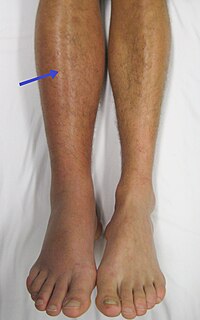
Photo from wikipedia
Skeletal muscle unloading due to joint immobilization induces muscle atrophy, which has primarily been attributed to reductions in protein synthesis in humans. However, no study has evaluated the skeletal muscle… Click to show full abstract
Skeletal muscle unloading due to joint immobilization induces muscle atrophy, which has primarily been attributed to reductions in protein synthesis in humans. However, no study has evaluated the skeletal muscle proteome response to limb immobilization using SWATH proteomic methods. This study characterized the shifts in individual muscle protein abundance and corresponding gene sets after 3 and 14 d of unilateral lower limb immobilization in otherwise healthy young men. Eighteen male participants (25.4 ±5.5 y, 81.2 ±11.6 kg) underwent 14 d of unilateral knee-brace immobilization with dietary provision and following four-weeks of training to standardise acute training history. Participant phenotype was characterized before and after 14 days of immobilization, and muscle biopsies were obtained from the vastus lateralis at baseline (pre-immobilization) and at 3 and 14 d of immobilization for analysis by SWATH-MS and subsequent gene-set enrichment analysis (GSEA). Immobilization reduced vastus group cross sectional area (-9.6 ±4.6%, P <0.0001), immobilized leg lean mass (-3.3 ±3.9%, P = 0.002), unilateral 3-repetition maximum leg press (-15.6 ±9.2%, P <0.0001), and maximal oxygen uptake (-2.9 ±5.2%, P = 0.044). SWATH analyses consistently identified 2281 proteins. Compared to baseline, two and 99 proteins were differentially expressed (FDR <0.05) after 3 and 14 d of immobilization, respectively. After 14 d of immobilization, 322 biological processes were different to baseline (FDR <0.05, P <0.001). Most (77%) biological processes were positively enriched and characterized by cellular stress, targeted proteolysis, and protein-DNA complex modifications. In contrast, mitochondrial organization and energy metabolism were negatively enriched processes. This study is the first to use data independent proteomics and GSEA to show that unilateral lower limb immobilization evokes mitochondrial dysfunction, cellular stress, and proteolysis. Through GSEA and network mapping, we identify 27 hub proteins as potential protein/gene candidates for further exploration.
Journal Title: PLoS ONE
Year Published: 2022
Link to full text (if available)
Share on Social Media: Sign Up to like & get
recommendations!